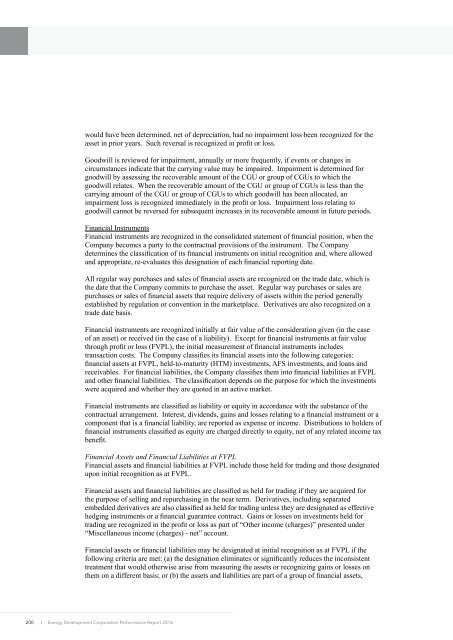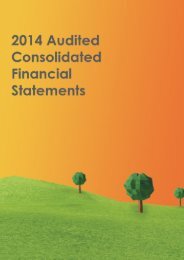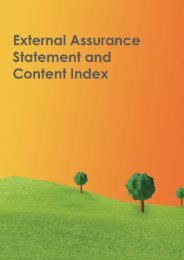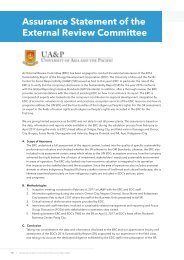EDC PR 2016 (FS section)
You also want an ePaper? Increase the reach of your titles
YUMPU automatically turns print PDFs into web optimized ePapers that Google loves.
would have been determined, net of depreciation, had no impairment loss been recognized for the<br />
asset in prior years. Such reversal is recognized in profit or loss.<br />
Goodwill is reviewed for impairment, annually or more frequently, if events or changes in<br />
circumstances indicate that the carrying value may be impaired. Impairment is determined for<br />
goodwill by assessing the recoverable amount of the CGU or group of CGUs to which the<br />
goodwill relates. When the recoverable amount of the CGU or group of CGUs is less than the<br />
carrying amount of the CGU or group of CGUs to which goodwill has been allocated, an<br />
impairment loss is recognized immediately in the profit or loss. Impairment loss relating to<br />
goodwill cannot be reversed for subsequent increases in its recoverable amount in future periods.<br />
Financial Instruments<br />
Financial instruments are recognized in the consolidated statement of financial position, when the<br />
Company becomes a party to the contractual provisions of the instrument. The Company<br />
determines the classification of its financial instruments on initial recognition and, where allowed<br />
and appropriate, re-evaluates this designation of each financial reporting date.<br />
All regular way purchases and sales of financial assets are recognized on the trade date, which is<br />
the date that the Company commits to purchase the asset. Regular way purchases or sales are<br />
purchases or sales of financial assets that require delivery of assets within the period generally<br />
established by regulation or convention in the marketplace. Derivatives are also recognized on a<br />
trade date basis.<br />
Financial instruments are recognized initially at fair value of the consideration given (in the case<br />
of an asset) or received (in the case of a liability). Except for financial instruments at fair value<br />
through profit or loss (FVPL), the initial measurement of financial instruments includes<br />
transaction costs. The Company classifies its financial assets into the following categories:<br />
financial assets at FVPL, held-to-maturity (HTM) investments, A<strong>FS</strong> investments, and loans and<br />
receivables. For financial liabilities, the Company classifies them into financial liabilities at FVPL<br />
and other financial liabilities. The classification depends on the purpose for which the investments<br />
were acquired and whether they are quoted in an active market.<br />
Financial instruments are classified as liability or equity in accordance with the substance of the<br />
contractual arrangement. Interest, dividends, gains and losses relating to a financial instrument or a<br />
component that is a financial liability, are reported as expense or income. Distributions to holders of<br />
financial instruments classified as equity are charged directly to equity, net of any related income tax<br />
benefit.<br />
Financial Assets and Financial Liabilities at FVPL<br />
Financial assets and financial liabilities at FVPL include those held for trading and those designated<br />
upon initial recognition as at FVPL.<br />
Financial assets and financial liabilities are classified as held for trading if they are acquired for<br />
the purpose of selling and repurchasing in the near term. Derivatives, including separated<br />
embedded derivatives are also classified as held for trading unless they are designated as effective<br />
hedging instruments or a financial guarantee contract. Gains or losses on investments held for<br />
trading are recognized in the profit or loss as part of “Other income (charges)” presented under<br />
“Miscellaneous income (charges) - net” account.<br />
Financial assets or financial liabilities may be designated at initial recognition as at FVPL if the<br />
following criteria are met: (a) the designation eliminates or significantly reduces the inconsistent<br />
treatment that would otherwise arise from measuring the assets or recognizing gains or losses on<br />
them on a different basis; or (b) the assets and liabilities are part of a group of financial assets,<br />
200<br />
I Energy Development Corporation Performance Report <strong>2016</strong>
















